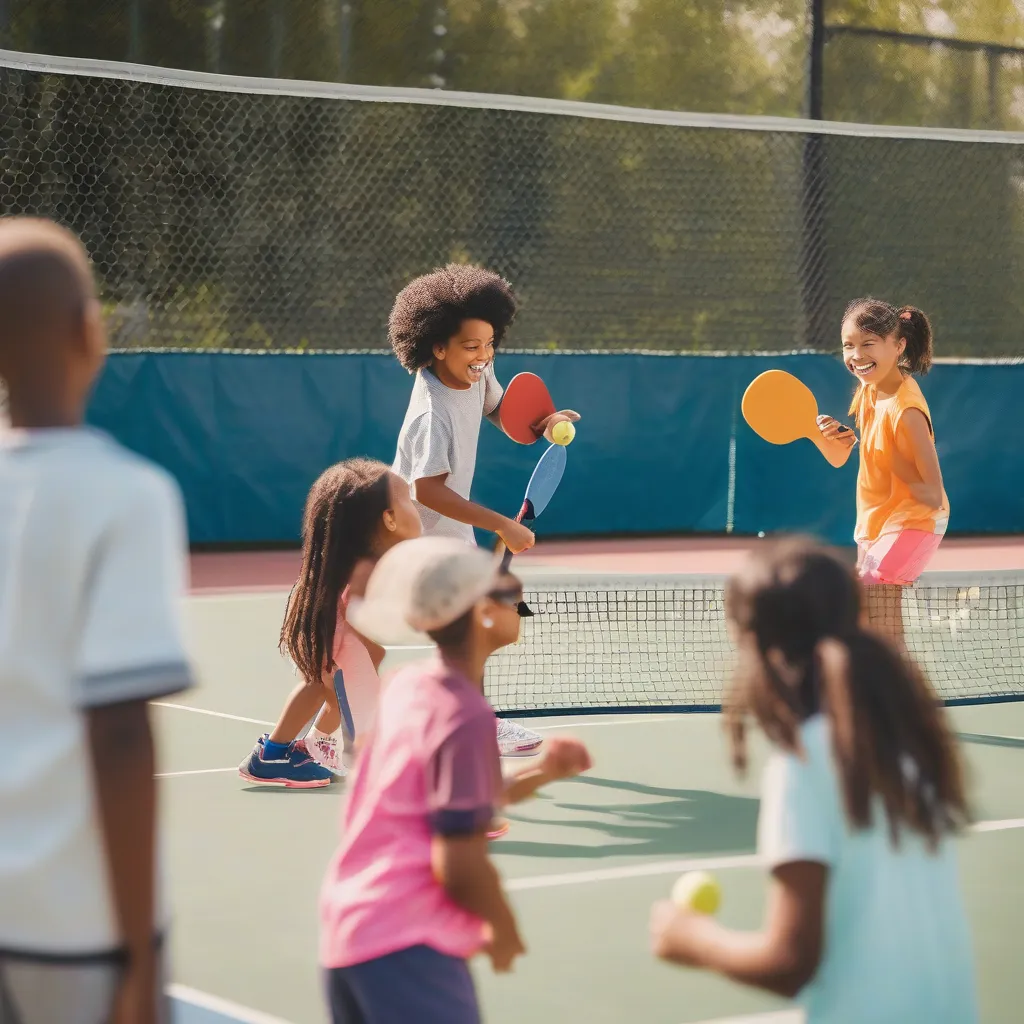Table of Contents
Introduction to Pickleball for Kids
Pickleball is a fantastic sport for kids, combining elements of tennis, badminton, and table tennis. It’s easy to learn, fun to play, and offers numerous physical and social benefits. This guide covers how to introduce pickleball for kids, with top tips for teaching and the benefits they can gain from playing.
Why Pickleball is Great for Kids
Pickleball is an excellent sport for kids for several reasons:
- Easy to Learn: The rules are simple, and the game is easy to pick up, making it accessible for children of all ages.
- Physical Fitness: Pickleball helps improve cardiovascular health, coordination, and overall fitness.
- Social Interaction: Playing pickleball encourages teamwork, communication, and social skills.
- Fun and Engaging: The fast-paced nature of the game keeps kids engaged and excited to play.
 Kids Playing Pickleball
Kids Playing Pickleball
Top Tips for Teaching Pickleball to Kids
1. Start with the Basics
Begin by teaching the basic rules and objectives of pickleball. Explain how to serve, score points, and the importance of the non-volley zone. Use simple language and demonstrate each concept clearly.
2. Use Age-Appropriate Equipment
Ensure that the equipment is suitable for children. Use lightweight paddles and lower nets to make the game more accessible and enjoyable for kids. Modified pickleball balls are also available for younger players.
3. Focus on Fun
Keep the sessions fun and engaging by incorporating games and challenges. Focus on developing skills through play rather than formal drills. This approach helps maintain their interest and enthusiasm for the sport.
4. Encourage Team Play
Promote teamwork by organizing doubles matches. Playing in pairs helps kids learn to communicate, cooperate, and develop social skills. It also makes the game more dynamic and enjoyable.
5. Practice Regularly
Encourage regular practice to help kids improve their skills and build confidence. Consistent practice sessions help reinforce learning and make the sport a regular part of their routine.
6. Offer Positive Feedback
Provide plenty of positive reinforcement to build their confidence and keep them motivated. Celebrate their successes and offer constructive feedback to help them improve.
7. Introduce Friendly Competitions
Organize friendly matches or mini-tournaments to give kids a taste of competitive play. Emphasize fun and participation over winning to keep the experience positive and stress-free.
Benefits of Pickleball for Kids
1. Physical Health
Playing pickleball helps kids develop cardiovascular fitness, strength, and coordination. It promotes a healthy lifestyle and encourages regular physical activity.
2. Mental Well-Being
Engaging in sports like pickleball boosts mental health by reducing stress, improving mood, and enhancing concentration. It provides a healthy outlet for energy and emotions.
3. Social Skills
Pickleball encourages kids to interact with their peers, develop teamwork, and improve communication skills. It helps them build friendships and learn the value of cooperation and sportsmanship.
4. Confidence and Self-Esteem
Learning and mastering new skills in pickleball boosts kids’ confidence and self-esteem. Achieving their goals and receiving positive feedback helps them feel accomplished and motivated.
5. Discipline and Focus
Regular practice and participation in sports teach kids discipline, focus, and perseverance. These qualities are valuable both on and off the court, contributing to their overall development.
Common Challenges and How to Overcome Them
While teaching pickleball to kids can be rewarding, it can also present some challenges. Here are common challenges and tips to overcome them:
1. Short Attention Spans
Keep sessions short and engaging to maintain their interest. Incorporate a variety of activities and games to keep them focused and excited.
2. Varying Skill Levels
Adapt your teaching methods to accommodate different skill levels. Group kids by ability and provide tailored instruction to ensure everyone can progress at their own pace.
3. Fear of Failure
Create a supportive environment where mistakes are viewed as learning opportunities. Encourage kids to try their best and reassure them that it’s okay to make errors while learning.
4. Maintaining Motivation
Set achievable goals and celebrate milestones to keep kids motivated. Incorporate rewards and incentives to recognize their efforts and progress.
Resources for Further Learning
For more detailed information on teaching pickleball to kids, explore these valuable resources:
- Visit the USA Pickleball Association (USAPA) for comprehensive guides and tips.
- Explore instructional videos and articles on Pickleball Central.
- Check out detailed reviews and tutorials on Pickleball Portal.
- Learn from top coaches and players on PickleballMAX.
Conclusion
Pickleball is a fun and engaging sport that offers numerous benefits for kids. By introducing pickleball to kids with the right approach and resources, you can help them develop physical fitness, mental well-being, social skills, and confidence. Use this guide to make the learning process enjoyable and rewarding, and watch as kids embrace the joy of playing pickleball.
Frequently Asked Questions
- Why is pickleball good for kids? Pickleball is good for kids because it is easy to learn, promotes physical fitness, encourages social interaction, and is fun to play.
- How can I introduce pickleball to my child? Start by teaching the basic rules and providing age-appropriate equipment. Focus on making the learning process fun and engaging.
- What are the benefits of pickleball for kids? Benefits include improved physical health, mental well-being, social skills, confidence, and discipline.
- Where can I find more information on pickleball for kids? Visit the USA Pickleball Association, Pickleball Central, Pickleball Portal, and PickleballMAX websites for comprehensive guides and tips.
- How can I keep my child motivated to play pickleball? Set achievable goals, provide positive feedback, and incorporate fun games and activities to keep them engaged and motivated.